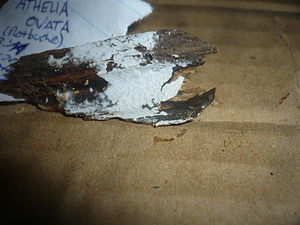Athelia ovata
| Athelia ovata | ||||||||||||
|---|---|---|---|---|---|---|---|---|---|---|---|---|

Athelia ovata |
||||||||||||
| Systematics | ||||||||||||
|
||||||||||||
| Scientific name | ||||||||||||
| Athelia ovata | ||||||||||||
| Jülich |
Athelia ovata is a stand mushroom art from the family of the tissue skin relatives (Atheliaceae). It forms resupinate, white and mold-like fruiting bodies on conifers and flowering seeds . The known distribution of the species includes large parts of the Palearctic , possibly also the Nearctic .
features
Macroscopic features
Athelia ovata , like all types of tissue membranes ( Athelia ), forms white to cream-colored, thin fruiting bodies with a smooth hymenium and inconspicuous to spider-like edges. They can be easily removed from the substrate.
Microscopic features
Athelia ovata has a monomitic hyphae structure typical of tissue membranes , that is, it only has generative hyphae that serve the growth of the fruiting body. The hyphae are hyaline and thin-walled. The subicular hyphae have occasional buckles , the subhymenial hyphae are simply septate and 4–5 µm wide. The species does not have cystidia . Their basidia are club-shaped, 16–18 × 5–7 µm in size and grow in nests. At the base they are simply septate, they have four, rarely two, sterigmata . The spores of the fungus are ellipsoid in shape, 8–9 × 3.8–4.2 µm in size, smooth and thin-walled, and hyaline. They have a distinct apiculus .
distribution
The known distribution of Athelia ovata includes Europe and the territory of the former USSR . Whether it also occurs in North America is uncertain, but is considered likely.
ecology
Athelia ovata is a saprobiont that attacks conifers and flowering plants. Well-known host species include European beech ( Fagus sylvatica ) and pine ( Pinus spp.).
Systematics
Athelia ovata was first described by Walter Jülich in 1972 . The species is probably close to Athelia arachnoidea and Athelia salicum .
literature
- Walter Jülich: Monograph of the Athelieae (Corticiaceae, Basidiomycetes). In: Wildenowia Beiheft 7, 1972. pp. 1–283.